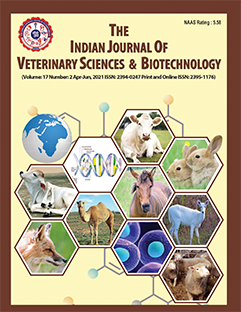Storage Potential and Chemical Composition of Wet Distillers Grains with Solubles (WDGS) Treated with Different Additives
DOI:
https://doi.org/10.48165/ijvsbt.21.3.17Keywords:
Additives, Chemical composition, Keeping quality, WDGSAbstract
To study the keeping quality of Wet Distillers Grains with Solubles (WDGS) during 12 days of the storage period, WDGS was treated with salt, citric acid, lactic acid, propionic acid and sulfuric acid at 1% of DM. No surface spoilage was observed up to 6 days in any of the treatments and up to 12 days in propionic and sulfuric acid treated WDGS. Mean pH was significantly lower (p<0.01) in 1% sulfuric acid treated WDGS. Mean NH3-N (mg/100g) concentration increased (p<0.01) from 0 day to 6th day and then decreased towards 12th day of storage among treatments with higher mean value in 1% sulfuric acid (100.32) and lower value in 1% propionic acid (67.26) treated WDGS. Yeast count increased towards 12th day of storage in all the treatments with higher counts in 1% salt treated WDGS. From 0 day to 12th day of storage, mean CP values were decreased significantly (p<0.01) with higher (p<0.01) mean CP value of 37.18% in propionic acid treated WDGS. Based on the overall results, it was concluded that WDGS can be stored up to 6 days without any additive, further with 1% propionic acid (DMB) treatment it can be stored up to 12 days in good quality.
Downloads
References
AOAC (2005). Official Methods of Analysis. 16th edn., Association of Official Analytical Chemists, Washington, DC.
Allen, W.R., Stevenson, K.R., & Buchanan-Smith, J.G. (1975). Influence of additives on short-term preservation of wet brewers’ grains stored in uncovered piles. Canadian Journal of Animal Science, 556, 609-618.
Alvarez. E., Cardoso, M., Bartosik, R., Depetris, G., Castellari, C., & Montiel, M.D. (2016). A preliminary comparative study of conventional and hermetic storage of wet distillers grains with soluble, pp. 324-328. In: Proceedings of the 10th International Conference on Controlled Atmosphere and Fumigation in Stored Products (CAF2016), CAF Permanent Committee Secretariat, Winninpeg, Canada.
Balamurugan, R., Valli, C., & Balakrishnan, V. (2018). Improving shelf life and nutritive value of wet distillers grain. Indian Journal of Veterinary and Animal Sciences Research, 47(1), 1236-1243.
Buckner, C.D., Wilken, M.F., Benton, J.R., Vanness, S.J., Bremer, V.R., Klopfenstein, T.J., Kononoff, P.J., & Erickson, G.E. (2011). Nutrient variability for distillers grains plus solubles and dry matter determination of ethanol by-products. The Professional Animal Scientist, 27(1), 57-64.
(2010). Evaluation of storage of covers when wet distillers byproducts are mixed and stored with for ages. Nebraska Beef Report, MP-93, 24-28.
Elzbieta, W., Krzysztof, K., & Magdalena, K. (2005). Microbiological quality of Animal Feeding stuffs in Poland. Bulletin of the Veterinary Institute in Pulawy, 49, 315-318.
Eslamian, E., Naserian, A.A., Tahmasbi, A. M., Valizadeh, R., & Kazemi, M. (2013). Nutritional evaluation of ensiled brewers’ grain by the in vitro and in situ techniques. International Journal of Biotechnology and Food Science, 1(5), 84-89.
FAO (2022). World Food and Agriculture – Statistical Yearbook 2022, Rome.
Hatungimana, E., & Erickson, P.S. (2019). Effects of storage of wet brewers’ grains treated with salt or a commercially available preservative on the prevention of spoilage, in vitro and in situ dry matter digestibility, and intestinal protein digestibility. Applied Animal Science, 35(5), 464-475.
Kazemi, M., Tahmasbi, A.M., Valizadeh, R., Naserian, A. A., Haghayegh, G.H., & Esmaeil J.Y. (2014). Studies on the effects of different chemical additives on the nutritive value of ensiled barley distillers’ grain (BDG) using in-vitro techniques. Direct Research Journal of Agriculture and Food Science, 2(2), 19-24.
Kitaw, G., Faji, M., & Terefe, G. (2022). Nutritional and fungal load dynamics of fresh brewers’ grain stored under aerobic conditions. AMB Express, 12(10), 2-7.
Klopfenstein, T.J., Erickson, G.E., & Bremer, V.R. (2008). Board-invited review: Use of distillers by-products in the beef cattle feeding industry. Journal of Animal Science, 86, 1223-1231.
McClurkin, J.D., & Ileleji, K.E. (2015). The effect of storage temperature and percentage of condensed distillers solubles on the shelf life of distillers wet grains stored aerobically. Journal of Stored Products Research, 62, 58-64.
Moriel, P., Artioli, L.F.A., Poore, M.H., & Ferraretto, L.F. (2015). Dry matter loss and nutritional composition of wet brewers’ grains ensiled with or without covering and with or without soybean
hulls and propionic acid. The Professional Animal Scientist, 31(6), 559-567.
Mussatto, S.I., Dragone, G., & Roberto, I.C. (2006). Brewers’ spent grain: generation, characteristics and potential applications. Journal of Cereal Science, 43(1), 1-14.
Santos, M.B., Nader, G.A., Robinson, P. H., Kiran, D., Krishnamoorthy, U., & Gomes, M.J. (2010). Impact of simulated field drying on in-vitro gas production and voluntary dry matter intake of rice straw. Animal Feed Science and Technology, 159, 96-104.
Sastry, V.R.B., Karma, D.N., & Pathak, N.N. (1999). Laboratory manual of Animal Nutrition. Division of Animal Nutrition, IVRI, Izatnagar, UP, India, p. 48.
Simas, M.M.S., Botura, M. B., Correa, B., Sabino, M., Mallmann, C.A., Bitencourt, T.C.B.S.C., & Batatinha, M.J.M. (2007). Determination of fungal microbiota and mycotoxins in brewers’ grain used in dairy cattle feeding in the State of Bahia, Brazil. Food Control, 18, 404-408.
Snedecor, G.W., & Cochran, W.G. (1994). Statistical Methods. 8th edn., Oxford and IBH Publishing Company, Calcutta, India. Zentek, J., Knorr, F., & Mader, A. (2014). Reducing waste in fresh produce processing and households through use of waste as animal feed. In; Global Safety of Fresh Produce. A Handbook of Best Practice, Innovative Commercial Solutions and Case Studies. Woodhead Publishing Series in Food Science, Technology and Nutrition, pp. 140-152.
Downloads
Published
Issue
Section
License
Copyright (c) 2025 Indian Journal of Veterinary Sciences and Biotechnology

This work is licensed under a Creative Commons Attribution-NonCommercial-NoDerivatives 4.0 International License.




